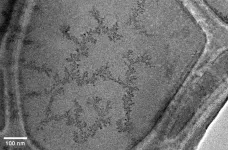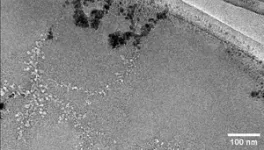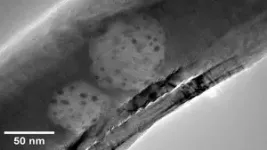(Press-News.org)
Scientists have for the first time filmed the real-time growth and contraction of Palladium nanoparticles, opening new avenues for utilising and recycling precious metal catalysts.
Researchers at the University of Nottingham’s School of Chemistry used transmission electron microscopy (TEM) to observe the complete lifecycle of palladium nanoparticles in a liquid environment, from nucleation through growth to dissolution, with the entire cycle repeating multiple times. This study has been published today in Nanoscale.
One of the most important applications of metal nanoparticles is in catalysis, which forms a backbone of chemical industries. Dr Jesum Alves Fernandes, an expert in the field, said: “The mechanisms of catalysis involving palladium have been hotly debated for many years, particularly as the distinction between homogeneous (in solution) and heterogeneous (on the surface of nanoparticles) catalysts becomes blurred at the nanoscale. The discovery that palladium nanoparticles can switch between these two modes can help us to develop new efficient catalysts for net-zero reactions, such as carbon dioxide reduction and ammonia synthesis. Additionally, this knowledge could help in the recycling and reuse of critical metals like palladium, whose global supplies are rapidly decreasing.”
The laws of thermodynamics cause chemical reactions, including those involving nanoparticles, to proceed in one direction. While oscillating chemical reactions are uncommon in manmade processes, they frequently occur in living organisms that exist away from thermodynamic equilibrium. Understanding these chemical oscillations could help us unravel some of nature's mysteries, including transitions from chaos to order, emergent behaviours, patterns in animal coats, and even the origins of life on Earth.
Professor Andrei Khlobystov, leads the research group at the University of Nottingham that focuses on imaging chemical reactions of individual molecules and atoms, in real time, and direct space, he says “We set out to study the formation of palladium nanoparticles in a liquid and were happy to observe the nanoparticles forming directly during TEM observation. These nanoparticles emerged from the palladium salt solution, growing larger and more structured over time. To our astonishment, once the nanoparticles reached a size of about 5 nanometres, they began to dissolve back into the solution, disappearing completely, only to undergo re-growth again.”
The nanoparticles create a complex branching pattern in a liquid pool, pulsating cyclically as they grow and dissolve. However, when the reaction is carried out in a droplet of solution contained within a carbon nanotube—serving as a miniature test tube—the lifecycle of the nanoparticles can be observed at atomic resolution. The carbon nanotube slows down the process, allowing for detailed observation of the early stages of nucleation, growth, and dissolution. This reveals a disk-like shape with crystal facets, suggesting interactions of the nanoparticles with the solvent molecules.
Dr Will Cull, a Research Fellow at the School of Chemistry, University of Nottingham, said: “The key to understanding this unexpected phenomenon lies in recognising that electron microscopy is a powerful imaging technique that can also alter the material being observed. This approach is often used to carve structures with the electron beam, but in this case, the energy of the electron beam is harnessed to break carbon-hydrogen bonds and displace valence electrons from the bromide anions in the solvent. As a result, chemical reactions are triggered while we image our sample.”
Dr Rhys Lodge, who conducted the measurements, explains: “We believe that the chemical reactions involving the solvent, activated by the electron beam, drive the reduction of palladium ions to palladium metal, as well as the oxidation of palladium metal back to palladium ions. Due to the competition between these two processes, the nanoparticles continuously grow and shrink, oscillating chemically between these two states.
This work is funded by the EPSRC Programme Grant ‘Metal atoms on surfaces and interfaces (MASI) for sustainable future’ www.masi.ac.uk which is set to develop catalyst materials for the conversion of three key molecules - carbon dioxide, hydrogen and ammonia – crucially important for economy and environment. MASI catalysts are made in an atom-efficient way to ensure sustainable use of chemical elements without depleting supplies of rare elements and making most of the earth's abundant elements, such as carbon and base metals.
The University of Nottingham is dedicated to championing green and sustainable technologies. The Zero Carbon Cluster has been recently launched in the East Midlands to accelerate the development and deployment of innovation in green industries and advanced manufacturing.
END
The world’s amphibians are in trouble. Because of their sensitivity to climate change, habitat loss, and pollution, they may be the canary in the coalmine for the nascent anthropogenic mass extinction. Approximately 200 amphibian species have become extinct since the 1970s, and the International Union for the Conservation of Nature estimates that 34% of the 7,296 known remaining species are likewise at risk.
Another reason why amphibians are vulnerable is their susceptibility to disease. An emerging, potentially deadly disease of frogs and salamanders is ranavirus, a genus of at least seven species within the family Iridoviridae. Ranavirus can rapidly jump ...
Designing walkable neighborhoods has gained attention as a method to increase physical activity among urban populations. Moreover, highly walkable areas stimulate increased neighborhood retail sales, higher property values, and greater urban sustainability. However, only limited methods are available for improving walkability in the urban centers of highly motorized suburban cities. In the urban areas of suburban cities, increasing land-use diversity by opening a multifunctional facility is considered one of the most effective strategies for an architecture-scale intervention.
Dr. Haruka Kato, ...
UNDER EMBARGO UNTIL 05:01 GMT / 01:01 ET WEDNESDAY 26 MARCH 2025
How elephants plan their journeys: New study reveals energy-saving strategies
A new study has revealed that African Elephants have an extraordinary ability to meet their colossal food requirements as efficiently as possible. Data from over 150 elephants demonstrated that these giants plan their journeys based on energy costs and resource availability. The findings – published today (26 March) in the Journal of Animal Ecology– could provide crucial information to help protect these iconic animals and their habitats.
Being an elephant is no easy task. As massive herbivores weighing several ...
Monogamous and non-monogamous individuals report similar levels of satisfaction in both their relationships and sex lives, according to a comprehensive new meta-analysis.
Published today in The Journal of Sex Research, the peer-reviewed study debunks the prevailing belief that monogamous relationships – defined as exclusive romantic and sexual commitment to one partner – are inherently superior in fostering fulfilling relationships compared to alternative structures.
While monogamy has been the predominant type of relationship in much of recent Western history, many individuals choose alternative structures. Non-monogamy includes various ...
His Excellency Dr. Irfaan Ali, President of the Co-operative Republic of Guyana, today announced a five-year extension of the national healthcare initiative to transform Guyana’s public health system with world-class healthcare services accessible to every Guyanese citizen. This next phase of the initiative, launched in 2022 by the Government of Guyana in collaboration with the Mount Sinai Health System and Hess Corporation, will include establishment of a national cancer center, continued modernization of national health facilities including Georgetown Public Hospital Corporation, and the implementation of one ...
A scientific technique that rapidly increases the body’s production of anti-inflammatory cells promoted healing from heart attacks in mice, according to a new study by investigators from the Smidt Heart Institute at Cedars-Sinai. Once adapted to treat humans, the technique could potentially be used to repair heart muscle damage after a heart attack and be applied to a variety of inflammatory disorders.
The investigators’ findings were published in the peer-reviewed Journal of Clinical Investigation.
Heart attacks occur when the heart muscle is damaged by reduced blood flow from one or more arteries. They strike more than ...
The sugar glucose, which is the main source of energy in almost every living cell, has been revealed in a Stanford Medicine study to also be a master regulator of tissue differentiation — the process by which stem cells give rise to specialized cells that make up all the body’s tissues.
It does so not by being catabolized, or broken down, to release the energy sequestered in its chemical bonds, but instead by binding in its intact form to proteins that control which genes in the genome are made into proteins and when.
The discovery of glucose’s undercover double life was so surprising the researchers ...
Women affected by premenstrual syndrome (PMS) appear to experience less intense and debilitating symptoms after taking placebo pills even when told they do not contain any active medication, suggests a study published in the open-access journal BMJ Evidence-Based Medicine.
PMS can result in significant distress for women of reproductive age and cause psychological symptoms such as irritability, depressed mood, and mood swings as well as physical symptoms including breast tenderness, bloating, and joint pain.
Women ...
New mums should be strongly encouraged to begin clocking up at least two hours of moderate to vigorous intensity physical activity such as brisk walking and muscle strengthening exercises each week in the first three months after birth, when physically able, to improve health and well-being, say experts in a new guideline published by the British Journal of Sports Medicine.
They also strongly recommend daily pelvic floor muscle training to reduce the risk of urinary incontinence, and taking steps to improve sleep ...
OKLAHOMA CITY – In 2010, University of Oklahoma researcher David Fields, Ph.D., was pouring over research data when he discovered something he thought was odd: His data showed that at 6 months of age, formula-fed babies born of mothers who were categorized as medically obese weighed about 5% units less fat than breastfed babies in the same dataset. That discovery struck him as unusual and led him on a research journey to better understand breast milk. Now, he’s studying the connections between maternal gestational diabetes, breastfeeding and infant health.
Fields is part of the research team behind a recent study ...






